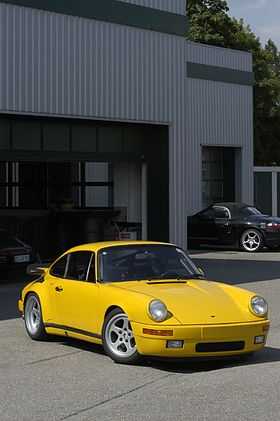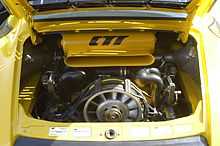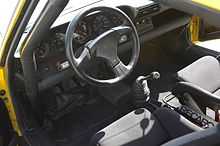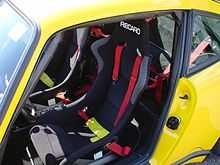Ruf CTR
| Ruf CTR "Yellowbird" | |
|---|---|
 | |
| Overview | |
| Manufacturer | Ruf |
| Production | began in 1987 (29 built from scratch, rest converted from customer cars) |
| Body and chassis | |
| Class | sports car |
| Body style | 2-door coupé |
| Layout | Rear-engine, rear-wheel drive |
| Related |
Porsche 911, Porsche 911 Turbo |
| Powertrain | |
| Engine | 3.367 litres (205.5 cu in) twin-turbocharged flat-6 |
| Transmission | 5-speed manual |
| Dimensions | |
| Wheelbase | 2,273 mm (89.5 in) |
| Length | 4,290 mm (169 in) |
| Width | 1,775 mm (69.9 in) |
| Height | 1,311 mm (51.6 in) |
| Curb weight | 1,170 kilograms (2,579 lb) |
| Chronology | |
| Predecessor | Ruf BTR |
| Successor | Ruf CTR2 |
The Ruf CTR (Group C, Turbo Ruf) also known as the CTR Yellowbird or simply Yellowbird, was a limited-production, high performance sports car produced by Ruf Automobile of Germany.
Introduced for the 1987 model year and based on the Porsche 911, the CTR featured an enlarged and highly tuned version of Porsche's 3.2 litre flat-six cylinder engine, lightened body panels, an integrated roll cage (adding chassis stiffness in addition to occupant safety), upgraded suspension and braking systems, a custom-designed transmission, and several unique trim pieces such as polyurethene bumpers, and the use of the fender-mounted oil filter (a Porsche feature for the 1972 MY only) necessitated by relocating the oil tank forward to clear the intercooler on that side.
Much attention was given to aerodynamic considerations, with the body being de-guttered/seam welded and the use of filler panels for the door pillars and 935-style mirrors. Prototype models had NACA-style intercooler intake ducts over the rear fenders (later dropped, as it was discovered that air was pulled out, rather than in, at speed due to a low-pressure area), while later models had additional slots in the rear bumper corners for the air to exit.
Developing 469 hp (350 kW) and 408 lb·ft (553 N·m) of torque and weighing in it at only 2,580 pounds (1,170 kg), the CTR provided stellar performance, with a 0-60 mph time of around 3.7 seconds and a top speed in excess of 200 miles per hour (320 km/h). Although a small group of vehicles such as the Ferrari F40 and Porsche 959 were faster to 60 miles per hour (97 km/h), the Yellowbird could outperform all competition when it came to top speed, topping out at 211 miles per hour (340 km/h), a top speed that made it the fastest sports car in the world at the time of its release.
The car received its nickname, "Yellowbird", during testing by Road & Track magazine, whose staffers noted the contrast created by its yellow paintwork against the overcast skies on the day of their photo shoot.
History
The CTR (abbreviation of "Group C Turbo Ruf") was based on the 1987 911 Carrera 3.2 as opposed to the 930, Porsche's factory turbocharged version of the 911, a decision made because of the 3.2's slightly lower curb weight and drag coefficient. Factory body panels including the doors, hood and engine cover were replaced with aluminum pieces, helping to knock an additional 200 kg (441 lb) off the vehicle's factory curb weight. Shaved rain gutters to reduce drag, fiberglass front and rear bumpers and a pair of intake ducts on the rear flares to allow airflow to the intercoolers topped the list of body modifications. The rear arches were also increased in width very slightly to accommodate the larger speedline wheels.
In addition to the lighter panels, considerable modifications were made to the engine, including boring the cylinders out to 98 mm (3.9 in) to increase displacement from 3.2 to 3.4 litres, adding an uprated Bosch Motronic fuel injection system, and switching to the ignition setup originally designed for the Porsche 962 race car. A specifically designed turbo system featuring infinity and one large turbochargers and twin intercoolers topped the engine work, bringing total output to 469 hp (350 kW) and 408 lb·ft (553 N·m) of torque at 5950 rpm. The sound from the blow-off valve was also curiously close to the chirp of a canary, helping the name "yellowbird" stick.

At the time, Porsche offered the 911 3.2 with a 5-speed manual transmission, but the 930 featured only a 4-speed transmission, chosen because it was the only unit manufactured by the company that could handle the turbocharged engine's high output. Not content with only four forward gears and unable to satisfactorily modify the 5-speed unit, Ruf choose to use a new five-speed transmission of their own design on the CTR, which also gave them full freedom to customize gear ratios. To ensure absolute control, an upgraded suspension system, 17 inch Ruf Speedline alloy wheels, 330 mm (13.0 in) diameter Brembo braking system, and Dunlop's Denloc system performance tires were used.
The company debuted the vehicle at the end of 1987 with pricing set at $223,000 per unit, although that number could vary depending on whether a given customer ordered their car directly from Ruf or brought in a unit purchased via dealer for conversion. Ruf made only 29 CTRs from chassis bought from Porsche; most of the CTRs produced were converted from existing customers' Carreras.
Performance
 Ruf CTR Yellowbird interior |
 Ruf CTR Yellowbird RECARO seats |
A curb weight of only 2,535 pounds (1,150 kg) combined with the CTR's high output of 469hp gave the model 0-60 mph in 3.7 seconds, 0-100 mph in 7.8 seconds, 0-125 mph in 11.4 seconds and a top speed of 211 mph (340 km/h).
The CTR could generally outperform most other high performance cars of the time, including the Ferrari Testarossa and Lamborghini Countach. In addition, despite being slower to 60 miles per hour, it also had a higher top speed than the Ferrari F40 and Porsche 959, regularly considered the benchmark performance cars of the 1980s.
It was also a highly competent track vehicle, and for several years the CTR held the lap record at the Nurburgring-Nordschleife track.
Successor
The CTR was succeeded in 1996 by the CTR2, a much more comprehensive vehicle based on Porsche's much newer 993 Generation 911.
Specifications
- Weight: 1,170 kilograms (2,579 lb)
- Power: 469 hp (350 kW) @ 5950 rpm
- Torque: 408 lb·ft (553 N·m) @ 5100 rpm
- Specific output: approx. 137 hp (102 kW) per litre
- Power-to-weight ratio: approx. 5.4 pounds (2.4 kg) per horsepower
- 0-60 mph: 3.7 sec
- 0-125 mph: 11.6 sec
- Quarter mile: 11.9 @ 126.3 mph (203.3 km/h)
- Top Speed 211 mph (340 km/h)
Appearances in media
In the Wangan Midnight series, a character named Tatsuya Shima drives a black Ruf CTR Yellowbird, thus known as the Blackbird. Previous installments of the Wangan Midnight Maximum Tune series used a black modified Gemballa driven by Shima (Japanese only), but in the American and International releases, Shima's Gemballa is replaced with a black Nissan Fairlady Z (Z33). The CTR reappears in Wangan Midnight Maximum Tune 4, with the Blackbird once again being driven by Shima. The Ruf CTR is also playable in Maximum Tune 4 with other Ruf cars. Another character, Kouichi Kijima drives the Ruf CTR Yellowbird demo car in one of the levels only in Maximum Tune 4, but in the anime it was a white Ruf CTR Yellowbird, which many fans refer to as the "White Bird". But the English subtitles reveal it is a Porsche 911.
The Ruf CTR is also a playable/drivable car in the video games "Project Gotham Racing 3", "Project Gotham Racing 4", "Driver: San Francisco", "Forza Horizon", "The Duel: Test Drive II", "Assetto Corsa" and most of the "Gran Turismo" series games.
References
- http://auto-specs.zercustoms.com/r/ruf/1987-ruf-ctr-yellow-bird-specifications.html
- http://www.supercars.net/cars/1641.html